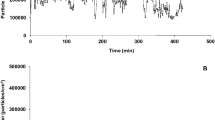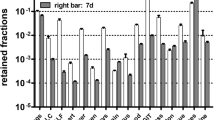Abstract
Recently revised OECD inhalation toxicity testing guidelines require measurements of lung burden immediately after and for periods following exposure for nanomaterials. Lung burden is a function of pulmonary deposition and retention of nanoparticles. Using lung burden studies as per OECD guidelines, it may be possible to assess clearance mechanisms of nanoparticles. In this study, male rats were exposed to silver nanoparticle (AgNP) aerosols (18.1–19.6 nm) generated from a spark generator. Exposure groups consisted of (1) control (fresh air), (2) low (31.2 ± 8.5 µg/m3), (3) moderate (81.8 ± 11.4 µg/m3), and (4) high concentrations (115.6 ± 30.5 µg/m3). Rats were exposed for 6-h/day, 5-days/week for 4 weeks (28-days) based on the revised OECD test guideline 412. Bronchoalveolar lavage (BAL) fluids were collected on post-exposure observation (PEO)-1 and PEO-7 days and analyzed for inflammatory cells and inflammatory biomarkers. The lung burdens of Ag from AgNPs were measured on PEO-1, PEO-7, and PEO-28 days to obtain quantitative mass concentrations per lung. Differential counting of blood cells and inflammatory biomarkers in BAL fluid and histopathological evaluation of lung tissue indicated that exposure to the high concentrations of AgNP aerosol induced inflammation at PEO-1, slowly resolved at PEO-7 and completely resolved at PEO-28 days. Lung burden measurement suggested that Ag from AgNPs was cleared through two different modes; fast and slow clearance. The fast clearance component was concentration-dependent with half-times ranging from two to four days and clearance rates of 0.35–0.17/day−1 from low to high concentrations. The slow clearance had half-times of 100, 57, and 76 days and clearance rates of 0.009, 0.012, and 0.007/day−1 for the high, moderate and low concentration exposure. The exact mechanism of clearance is not known currently. The fast clearance component which was concentration-dependent could be dependent on the dissolution of AgNPs and the slow clearance would be due to slow clearance of the low dissolution AgNPs secondary particles originating from silver ions reacting with biogenic anions. These secondary AgNPs might be cleared by mechanisms other than dissolution such as mucociliary escalation, translocation to the lymphatic system or other organs.



Similar content being viewed by others
Availability of supporting data
All data and materials are included in the manuscript, tables, figures and supplements.
References
Anderson DS, Patchin ES, Silva RM, Uyeminami DL, Sharmah A, Guo T, Das GK, Brown JM, Shannahan J, Gordon T, Chen LC, Pinkerton KE, Van Winkle LS (2015) Influence of particle size on persistence and clearance of aerosolized silver nanoparticles in the rat lung. Toxicol Sci 144(2):366–381
Braakhuis HM, Gosens I, Krystek P, Boere JA, Cassee FR, Fokkens PH, Post JA, van Loveren H, Park MV (2014) Particle size dependent deposition and pulmonary inflammation after short-term inhalation of silver nanoparticles. Part Fibre Toxicol. 11:49
ISO (International Organization for Standardization), ISO/TR 22019 (2019) Nanotechnologies-Considerations for performing toxicokinetic studies for nanomaterials, Geneva: ISO
Ji JH, Jung JH, Yu IJ, Kim SS (2007) Long-term stability characteristics of a nanoparticle generator using a small ceramic heater with a local heating area for inhalation toxicity study. Inhalation Toxicol 19:745–751
Miller FJ, Asgharian B, Schroeter JD, Price OT (2016) Improvements and additions to the multiple path particle dosimetry model. J Aerosol Sci 99:14–26
Multiple-Path Particle Dosimetry Model (MPPD v. 3.04. https://www.ara.com/products/multiple-path-particle-dosimetry-model-mppd-v-304. Accessed 01 Sep 9 2018
NIOSH (National Institute for Occupational Safety and Health) (2003) NIOSH manual of analytical method 7300. Cincinnati: Elements by ICP (Nitric/perchloric acid ashing). NIOSH, Cincinnati
NIOSH (National Institute for Occupational Safety and Health) (1994) NIOSH manual of analytical method 7402. Asbestos by TEM. NIOSH, Cincinnati
Oberdörster G (1988) Lung clearance of inhaled insoluble and soluble particles. J Aerosol Med 4(1):289–330
Oberdörster G, Oberdörster E, Oberdörster J (2005) Nanotoxicology: an emerging discipline evolving from studies of ultrafine particles. Environ Health Perspect E 113(7):823–839
OECD (Organization for Economic Cooperation and Development) (2010) OECD guideline for the testing of chemicals 417, Toxicokinetics. OECD, Paris
OECD (Organization Economic Cooperation and Development) (2018a) OECD guideline for the testing of chemicals 412, 28-day (subacute) inhalation toxicity study. OECD, Paris
OECD (Organization Economic Cooperation and Development) (2018b) OECD guideline for the testing of chemicals 413, 90-day (subchronic) inhalation toxicity study. OECD, Paris
Park JD, Kim JK, Jo MS, Kim YH, Jeon KS, Lee JH, Faustman EM, Lee HK, Ahn K, Gulumian M, Oberdörster G, Yu IJ (2019) Lobar Evenness of deposition/retention in rat lungs of inhaled silver nanoparticles: an approach for reducing animal use while maximizing endpoints. Part Fibre Toxicol 16:2
Seiffert J, Buckley A, Leo B, Martin NG, Zhu J, Dai R, Hussain F, Guo C, Warren J, Hodgson A, Gong J, Ryan MP, Zhang JJ, Porter A, Tetley TD, Gow A, Smith R, Chung KF (2016) Pulmonary effects of inhalation of spark-generated silver nanoparticles in Brown-Norway and Sprague-Dawley rats. Respir Res 17(1):85
Song KS, Sung JH, Ji JH, Lee JH, Lee JS, Ryu HR, Lee JK, Chung YH, Park HM, Shin BS, Chang HK, Kelman B, Yu IJ (2013) Recovery from silver-nanoparticle-exposure-induced lung inflammation and lung function changes in Sprague Dawley rats. Nanotoxicology 7(2):169–180
Stuart BO (1984) Deposition and clearance on inhaled particles. Environ Health Perspect 55:369–390
Sung JH, Ji JH, Park JD, Yoon JU, Kim DS, Jeon KS, Song MY, Jeong J, Han BS, Han JH, Chung YH, Chang HK, Lee JH, Cho MH, Kelman BJ, Yu IJ (2009) Subchronic inhalation toxicity of silver nanoparticles. Toxicol Sci 108(2):452–461
Takenaka S, Karg E, Kreyling WG, Lentner B, Möller W, Behnke-Semmler M, Jennen L, Walch A, Michalke B, Schramel P, Heyder J, Schulz H (2006) Distribution pattern of inhaled ultrafine gold particles in the rat lung. Inhalation Toxicol 18:733–740
Walker M, Parsons D. (2014) The biological fate of silver ions following the use of silver-containing wound care products—a review. 11(5):496–504
Funding
This study was supported by the Global Top Environment Technology Development project (No. 2018001860004) funded by the Ministry of Environment.
Author information
Authors and Affiliations
Contributions
MSJ experimental and manuscript preparation; YK, experimental preparation; HPK, experimental preparation; HSK, nanomaterial generation and monitoring; KA, aerosol monitoring advice; JHL, silver analysis advice and manuscript review; EMF, manuscript review and statistical review; MG, advice and manuscript review, revision; BK, advice and manuscript review, revision; IJY, experimental planning, manuscript preparation and review. All authors read and approved the final manuscript.
Corresponding author
Ethics declarations
Conflict of interest
The authors declare that they have no competing interest.
Ethics approval and consent to participate
The study was carried out in agreement with Korean Animal Welfare Act. The study was approved by the Hanyang University’s Institutional Animal Care and Use Committee (2017-0234A).
Additional information
Publisher's Note
Springer Nature remains neutral with regard to jurisdictional claims in published maps and institutional affiliations.
Electronic supplementary material
Below is the link to the electronic supplementary material.
Rights and permissions
About this article
Cite this article
Jo, M.S., Kim, J.K., Kim, Y. et al. Mode of silver clearance following 28-day inhalation exposure to silver nanoparticles determined from lung burden assessment including post-exposure observation periods. Arch Toxicol 94, 773–784 (2020). https://doi.org/10.1007/s00204-020-02660-2
Received:
Accepted:
Published:
Issue Date:
DOI: https://doi.org/10.1007/s00204-020-02660-2




